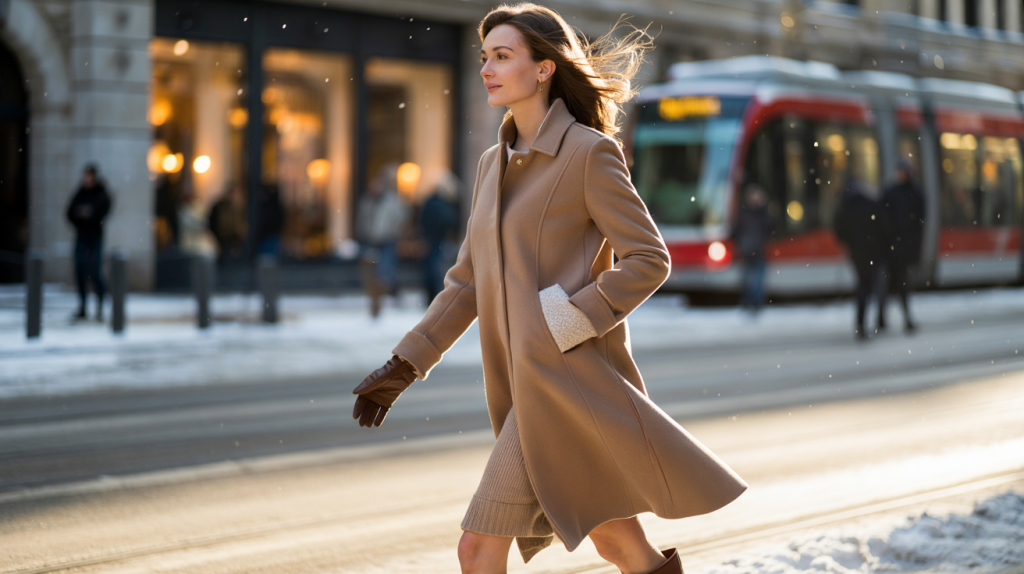Winter bites, style holds. When the brief says elegant and comfortable, the right women’s coat simply does both: it warms without bulk and elevates every outfit from dawn to late trains.
The quick path looks clear. Choose premium wool or a responsibly sourced down option for real insulation, then focus on cut, lining, closures and length. Neutral tones feel polished, textured fabrics add depth, and details like a stand collar or storm placket seal in comfort during a windy commute. Keep reading, the differences that matter show up fast.
Elegant and comfortable women’s winter coat essentials in 2025
City weather shifts more in a single day than a closet does in a season. A timeless wool coat covers meetings and nights out, while a lightweight down topper handles icy mornings with less weight. The elegant choice comes from balance: clean lines, quiet hardware, smooth drape, and warmth that does not fight your movement.
Start with lifestyle. If the day includes walking, queueing, stepping on buses, insulation must work with breathability to avoid the midday overheat. If most time is indoors, prioritize drape, tailoring and a soft handfeel, then layer a thin knit underneath for thermal control.
Common friction points appear at shoulders, elbows and the back vent. A coat that looks sharp on a hanger can pull once a blazer sits under it. Test reach and cross-body bag movement before buying, and sit down in the coat to check ease across the hips.
Fabrics decoded: wool, cashmere, down and recycled fibers that perform
Wool remains the winter benchmark for poise and comfort. The Woolmark Company reports that wool can absorb around 30 percent of its weight in moisture vapor without feeling wet, which helps regulate body climate when moving between cold streets and heated rooms, source : Woolmark, 2023. Cashmere blends add softness and drape, best kept for dry days or paired with a scarf barrier around makeup zones.
Down excels when weight matters. REI Co-op notes that quality down jackets typically range from 550 to 900 fill power, where higher numbers loft more and trap more air for warmth at lower weight, source : REI Co-op Expert Advice, 2024. Choose a tightly woven shell for wind resistance and consider a removable hood to switch from casual to tailored in seconds.
Synthetics bring durability and price range, though they shed microfibers during washing. The International Union for Conservation of Nature attributes 35 percent of primary microplastics in the ocean to synthetic textiles, source : IUCN, 2017. If choosing polyester or nylon, look for recycled content and OEKO-TEX Standard 100 labels that screen for harmful substances.
Responsible sourcing signals matter. For down, Responsible Down Standard labels trace welfare through the supply chain. For wool, look for Responsible Wool Standard or local farm certifications that document land and animal care. These tags are quiet on the lining but loud on peace of mind.
Quick checklist for a manteau hiver femme élégant et confortable :
- Fabric : 70 to 80 percent wool for city wear, or 700 fill power down for very cold commutes
- Lining : smooth viscose or cupro for glide over knits and blazers
- Length : knee or mid-calf for warmth and proportion with boots
- Closure : hidden buttons or a covered zipper for a refined front
- Collar : stand or funnel collar that seals the neck on windy days
- Pockets : fleece lined hand pockets that actually warm hands
- Certifications : RDS for down, RWS for wool, OEKO-TEX for materials
Fit, length and tailoring that flatter without freezing
Elegance starts where shoulders sit right. The seam should land at the shoulder point, not the bicep. Allow a finger or two of ease at the underarm when wearing your thickest knit. A back vent or two side vents give stride while keeping the line clean.
Length does more than people think. A knee length wrap coat smooths the silhouette of dresses and wide-leg trousers. A mid-calf overcoat reads formal and traps more warm air around legs during long waits outside. Petite frames benefit from above-knee hems with vertical seaming that lengthens the look.
Breathability can be measured, not guessed. Many labs test with ISO 11092, where a Resistance to Evaporative Heat Transfer value below 6 ranks as very breathable, 6 to 13 as good, and above 20 as poor for active use, source : ISO 11092. A fully sealed parka feels cozy at a bus stop, yet can run hot inside a packed tram. Venting zips or a two way front zipper quickly tune comfort without sacrificing polish.
Smart care and budget: certifications, durability and small eco wins
Care habits extend life. Brush wool after wear to lift dust, then steam lightly to refresh shape. Space on a broad hanger helps the shoulders keep form. For synthetics, a laundry bag designed to capture fibers reduces microplastic release by an average of 54 percent during machine washing, source : Fraunhofer UMSICHT, 2018. Down prefers spot cleaning and low tumble with dryer balls to restore loft.
Cost per wear makes the numbers honest. A 300 dollar coat worn three times a week from November to March gives roughly 60 wears a season. Over three winters that is 180 wears, so less than 1.70 dollars each time. Spend where tailoring and fabric touch the eye and the skin, then accesorize with scarves and gloves to rotate looks.
One last gap often explains discomfort on cold days. Wind leakage. A cleanly stitched front placket with secure closures blocks drafts at the chest, and a high collar removes the need for bulky scarves on quick errands. Once those two elements align with the right fabric and fit, elegance meets comfort with no argument.
